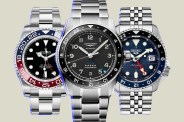If ever there were a hyped watch complication, it’s the GMT in the 2020s. It’s popularity is justified on several counts: complications make a watch more interesting, and the GMT is one of the most accessible steps above a watch with just basic time telling — at least, it’s more affordable than the ever-popular chronograph. Moreover, the extra hand and common addition of the (often colorful) rotating bezel lend themselves to fun sporty designs. But most of all, a GMT is actually useful in modern life.
There’s a lot to unpack in all those great reasons to want a GMT, and that’s exactly what we do below. Here’s what you need to know about GMT watches, where they come from, how they work and why they’re cool.
Origin of the GMT Watch

On May 2, 1952, 36 people boarded a De Havilland Comet jet owned by the British Overseas Airways Corporation (BOAC) and flew nonstop from London to Johannesburg. The Jet Age had officially begun. Pan Am quickly ordered 20 of Boeing‘s new 707 jetliners and built its WorldPort terminal at JFK while TWA countered with its own World Flight Center. It was a brave new world that saw cigarettes on planes but not a roller bag to be found. People were suddenly able to fly across oceans and time zones in a day, which also introduced the decidedly modern ailment known as jet lag.
The pilots flying these long haul routes needed a way to keep track of time, both local time and the time in the place from where they departed. Introduced in 1953, the Glycine Airman was made to meet their needs with a watch displaying the time in 24-hour (rather than 12-hour) format, featuring a rotating bezel and 24-hour markings that could be used to track a second time zone. It’s a cool and interesting solution (and the watch is still available today), but it wasn’t the one that caught on.
Pan Am approached Rolex, the watch brand that Hillary wore up Everest and Cousteau wore in the deep, and requested a watch built for this new breed of pilots. In 1954, the GMT-Master, a watch that could mechanically track two time zones simultaneously, was born.






